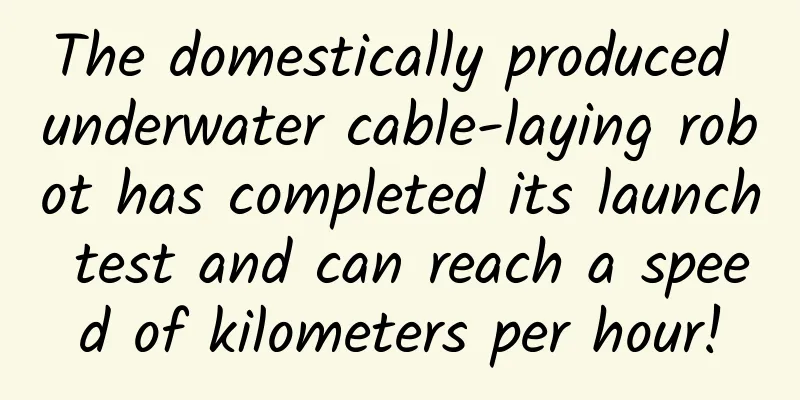The domestically produced underwater cable-laying robot has completed its launch test and can reach a speed of kilometers per hour!

|
Author: Shi Xiangqi and Li Chuanfu In today's rapidly developing technological era, underwater engineering technology is becoming one of the focuses of global attention. Recently, my country has made a major breakthrough in this field - the first domestically produced underwater cable laying robot successfully completed the launch test, and its operating speed reached an amazing kilometer level, that is, it can lay 1,000 meters of cable per hour. This achievement not only demonstrates my country's independent innovation capabilities in the field of high-end equipment manufacturing, but also injects new impetus into the development of global underwater engineering technology. The research and development of this underwater cable-laying robot is carried out against the background of the continuous development and growth of my country's offshore renewable energy power generation. As submarine cable laying construction faces new challenges, the previous operation methods and scenarios are restricted. Foreign underwater cable-laying robots cannot adapt to the soft soil in my country's offshore areas, and there are problems such as easy sinking and difficulty in moving. Therefore, in order to meet the growing demand for submarine operations, the research of underwater cable-laying robots has become urgent. The underwater cable-laying robot has the ability to walk on tracks and sleds and the integrated operation capability of "searching-digging-laying". The laying speed can reach 1,000 meters per hour, and the core components of the robot are 100% autonomous and controllable. This means that the project has transitioned from theoretical research to the prototype stage, demonstrating my country's independent innovation capabilities in the field of high-end equipment manufacturing. In response to the common problems of underwater cable-laying robots, such as weak submarine cable perception and short continuous operation time, Guangdong Power Grid Company, together with scientific research institutions and enterprises such as the Institute of Automation of the Chinese Academy of Sciences, Harbin Engineering University and Shandong Future Robotics Co., Ltd., has formed an elite multidisciplinary research team. The team has developed an efficient submarine cable detection and positioning method by innovatively integrating "acoustic-optical-magnetic-electric" multimodal information, and successfully overcome the anti-interference technical difficulties in multi-sensor combined navigation. This innovation not only solves the problem of difficulty in searching and locating submarine cables in low-visibility underwater environments, but also effectively avoids the problem of failure of near-bottom underwater navigation. Considering the complexity of the seabed environment, the project team carefully designed two travel modes: crawler and sled. Both modes can achieve stable travel on the soft soil seabed, thus effectively solving the problem of robot travel in such complex environments. The robot developed this time will be fully applicable to the soft soil seabed environment in my country's offshore areas. Its maximum burial operation speed can reach 1,000 meters per hour, which is nearly doubled compared to traditional operation methods. This achievement not only paves the way for the advancement of my country's marine engineering technology, but also provides new solutions for the development of global underwater engineering technology. In the future, we expect more technological products like this to emerge and contribute more to the country's construction and development. |
>>: These "grapes" are free, but they can cost you your life!
Recommend
In addition to drinking milk, these 9 ways to supplement calcium are cheap and effective! The sixth one you definitely didn't expect...
Calcium plays a vital role in the formation of hu...
Understand the real 『REM』 mobile screen adaptation
As a low-key unit of length, rem has been reused ...
Is Bilibili’s brand account “rising”?
When it comes to brand names, you automatically a...
Innovative operation activities: National Day operation activities based on gamification packaging
Nowadays, product operation activities are divers...
Suihua Mini Program Agency Company, how much does it cost to be an agent for an e-book mini program?
Is it easy to be an agent of Suihua e-book mini p...
Analysis and application of WebView cache principle
[[191419]] 1. Background Nowadays, App developmen...
Introduction to OPPO App Store Search Ads
FAQ - Search Ads Q1: Where are the ads in search ...
4 carefully selected WeChat mini-programs to make your phone omnipotent
Here we share 4 carefully selected WeChat applets...
Waymo, the world's leading autonomous driving company under Google, has entered China. Can Baidu win again?
Amid the endless stream of news events, the news ...
Technology "cultivates" new things丨Beidou, 5G and autonomous driving are also used in the fields
...
Information flow methodology helps you reduce costs by 40%!
There are a lot of form leads, but few transactio...
Imitation of WeChat voice sending interface
Source code introduction: imitate WeChat voice se...
After the bonus period, you should take this complete guide to channel operation
The traffic dividend has passed, so how will traf...
User search behavior value: Analysis of the value of vertical search engine data
Vertical search engines are search windows provid...
How did VIPKID build a customer acquisition system with a 70% referral rate?
VIPKID is the fastest growing online English educ...









